19 Circulation and Flux
Having an introduction to vector fields and their derivatives, we turn to their integrals. Many real world quantities arise as the integrals of vector fields, for example:
- Did the wind outside improve or hurt my time running a race?
- How does a magnetic field circulate around a wire?
- How much water flowed through my fishing net as I was trawling?
- How much power is available in the wind passing through a windmill?
- How much sunlight is hitting a solar panel, when the sun is at an angle in the sky?
- Where did a collision occur in a particle detector, given the spray of particles we see?
These sorts of questions essentially fall into two different categories: one is trying to measure how much a vector fields is pointed along a curve and the other is measuring how much a vector field flows through a region. We will refer to the first of these as the circulation* of a vector field, and the second as its flux.
19.1 Circulation
Circulation is defined given an oriented curve (that is, a curve with a specified direction for its parameterization) and a vector field. The goal is to measure whether the vector field’s net affect is to point along the direction of motion for the curve, or to point against the motion of the curve. We will call the former positive circulation and the latter negative circulation.
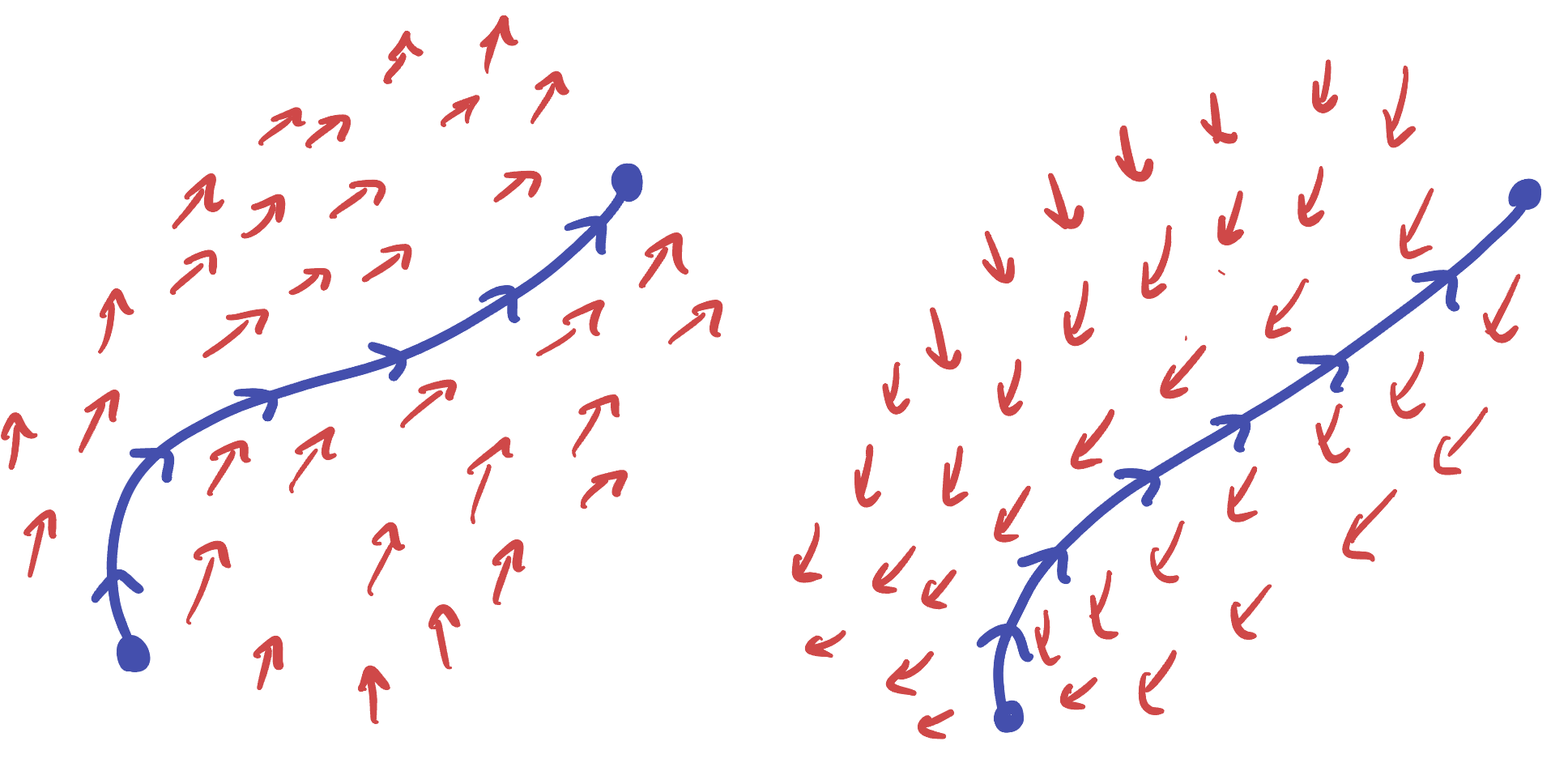 The left vector field has positive circulation along the curve, whereas the right has negative.
The left vector field has positive circulation along the curve, whereas the right has negative.
A vector field has zero circulation along a curve if it overall neither aligns or anti-aligns on average. This can happen in several ways: perhaps it lines up with the curve half the time and opposes it the other half, or alternatively could simply be perpendicular to the curve at all times.
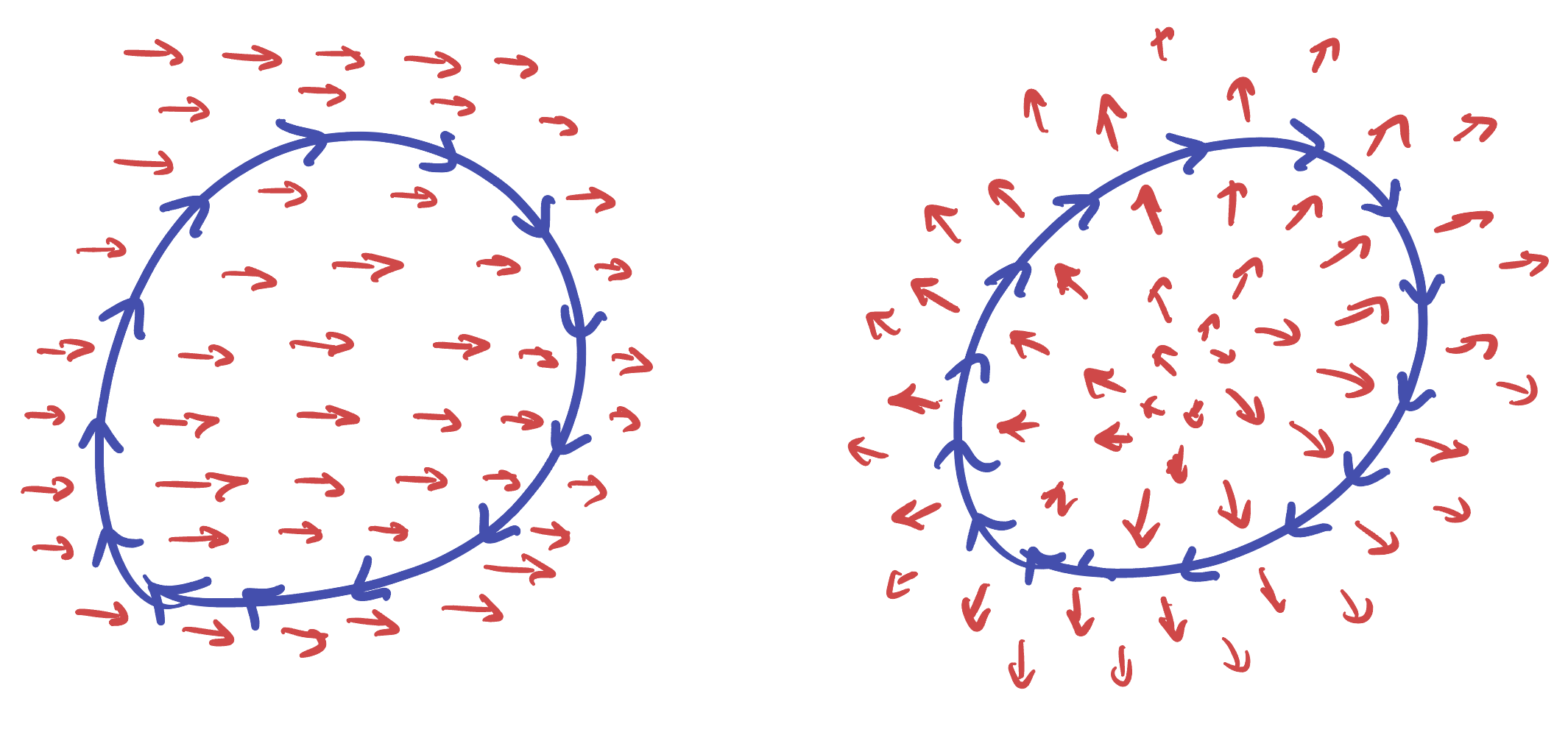 These two vector fields have zero circulation around the curve.
These two vector fields have zero circulation around the curve.
We need to do some work now to turn this definition into a precise mathematical quantity. Since we are measuring a net affect along a curve, we can greatly simplify things by breaking down into two steps
- Quantify how well a vector field aligns / anti-aligns with a curve at a point.
- Get the net affect by adding these all up in a line integral along the curve.
Focusing on point (1), we can zoom in on a single point along our curve
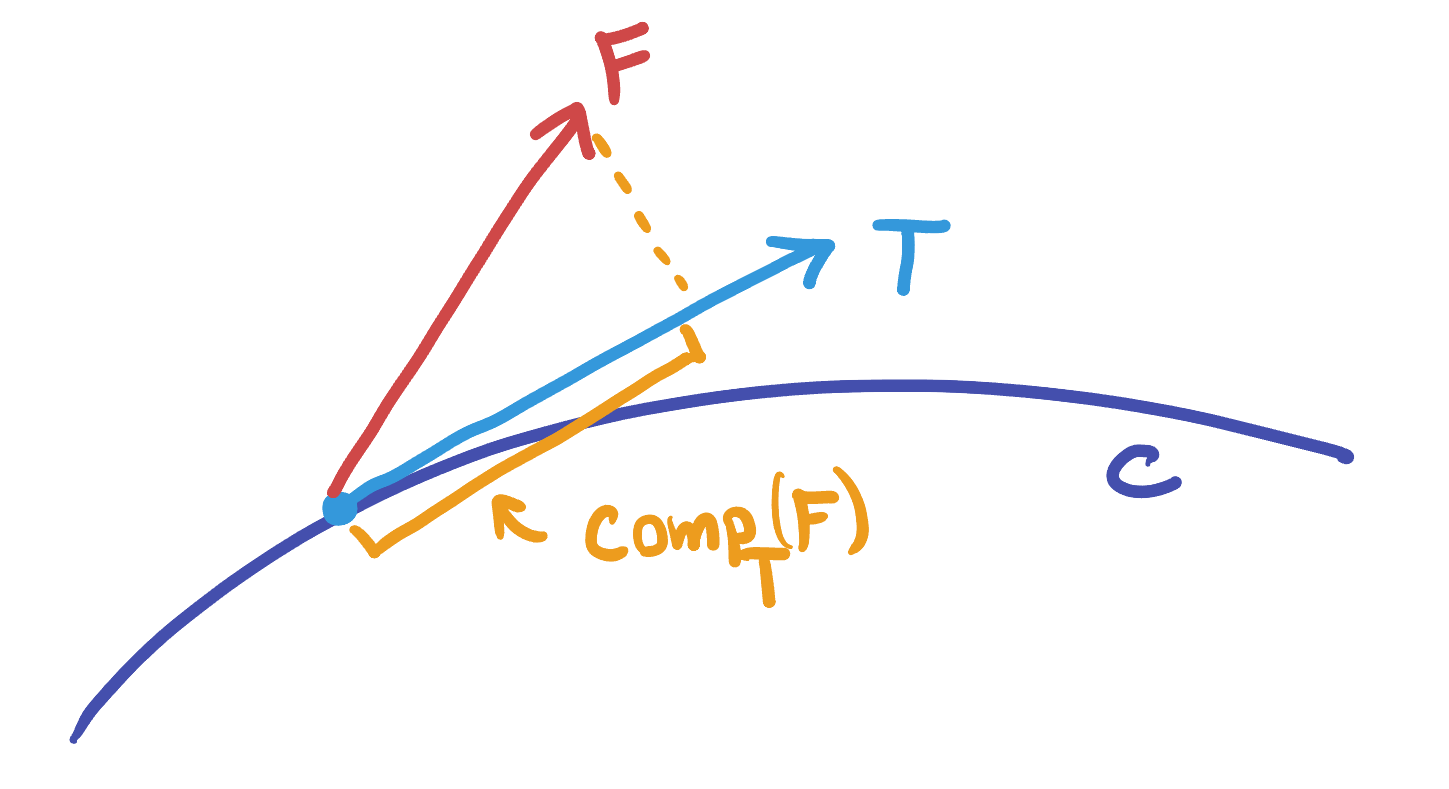
We can compute this by choosing any tangent vector
Definition 19.1 (Circulation Integral) The circulation of a vector field
Now that we have a conceptual formula down, lets try to simplify it into something usable. Given a parameterization
This simplifes greatly inside of a line integral, because the definition of infinitesimal arclength also involves
The norms cancel and we end up with a relatively simple integral: just the dot product of
Theorem 19.1 (Circulation Integral, in Usable Form) Given a vector field
Let’s do a quick example to confirm this is an easy computation:
Example 19.1 Compute the circulation of
We compute the vector field along the curve by simply subbing in the curves
If the curve
Like many things in multivariable calculus, there are multiple notations for the circulation integral, suited to different purposes. In addition to the form we have right now
Which is easy to unpack directly back to our other notation by substituting in the definition of
This is our integrand, and so we can rewrite the circulation as
using the shorthand that
We collect all these notations below in one place for future reference.
Definition 19.2 (Notation for Circulation Integrals) Given an oriented curve
19.2 Flux
The story of flux through a curve is very similar to circulation, save one crucial detail. We are no longer interested in flow along the curve but rather flow through. We make the convention that if a curve is closed (which will be our most common use case) positive means net flow outwards and negative is flow inwards
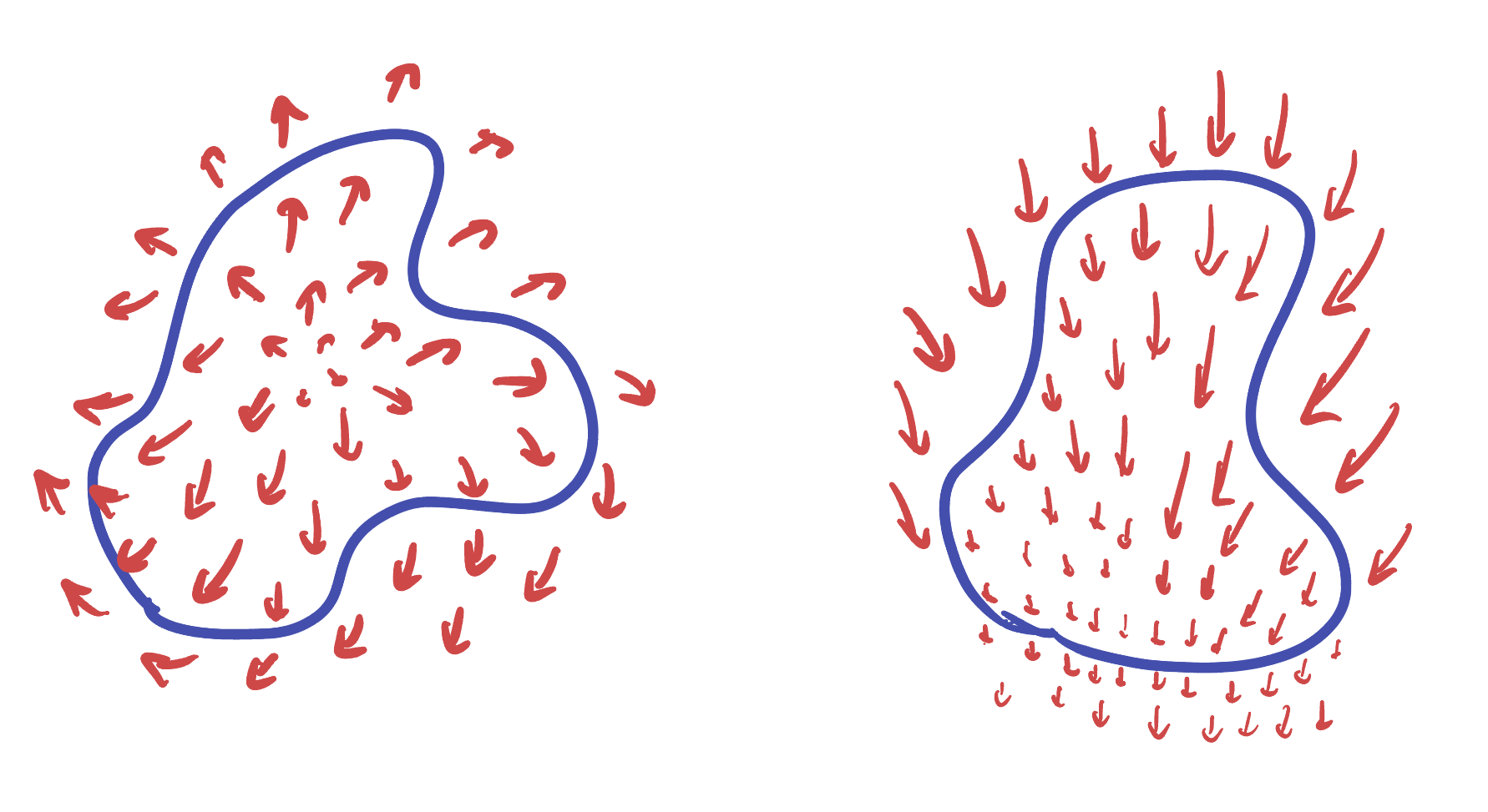 Positive flux (left) as the vector field is flowing out of the curve at all points. Negative flux (right) even though the vector field is flowing overall downwards (into the curve at the top and out at the bottom), the inflow is greater than the outflow so the net flux is inwards.
Positive flux (left) as the vector field is flowing out of the curve at all points. Negative flux (right) even though the vector field is flowing overall downwards (into the curve at the top and out at the bottom), the inflow is greater than the outflow so the net flux is inwards.
And for an otherwise arbitrary parameterized curve, we will call positive flow from left to right along the direction of motion, and negative a flow from right to left (this matches with the above when a closed curve is parameterized counterclockwise - the math standard orientation).
 The sign of flux has to do with the relative orientation of the curve and vector field. The left shows positive flux and the right negative flux, even though the vector field in both cases goes left to right.
The sign of flux has to do with the relative orientation of the curve and vector field. The left shows positive flux and the right negative flux, even though the vector field in both cases goes left to right.
Again its clear the net flow is going to be a line integral of the flow through a point, and so we need only compute it locally. Here sits the only change from our previous case: to measure outflow we are now concerned about the projection onto the normal instead of the tangent:
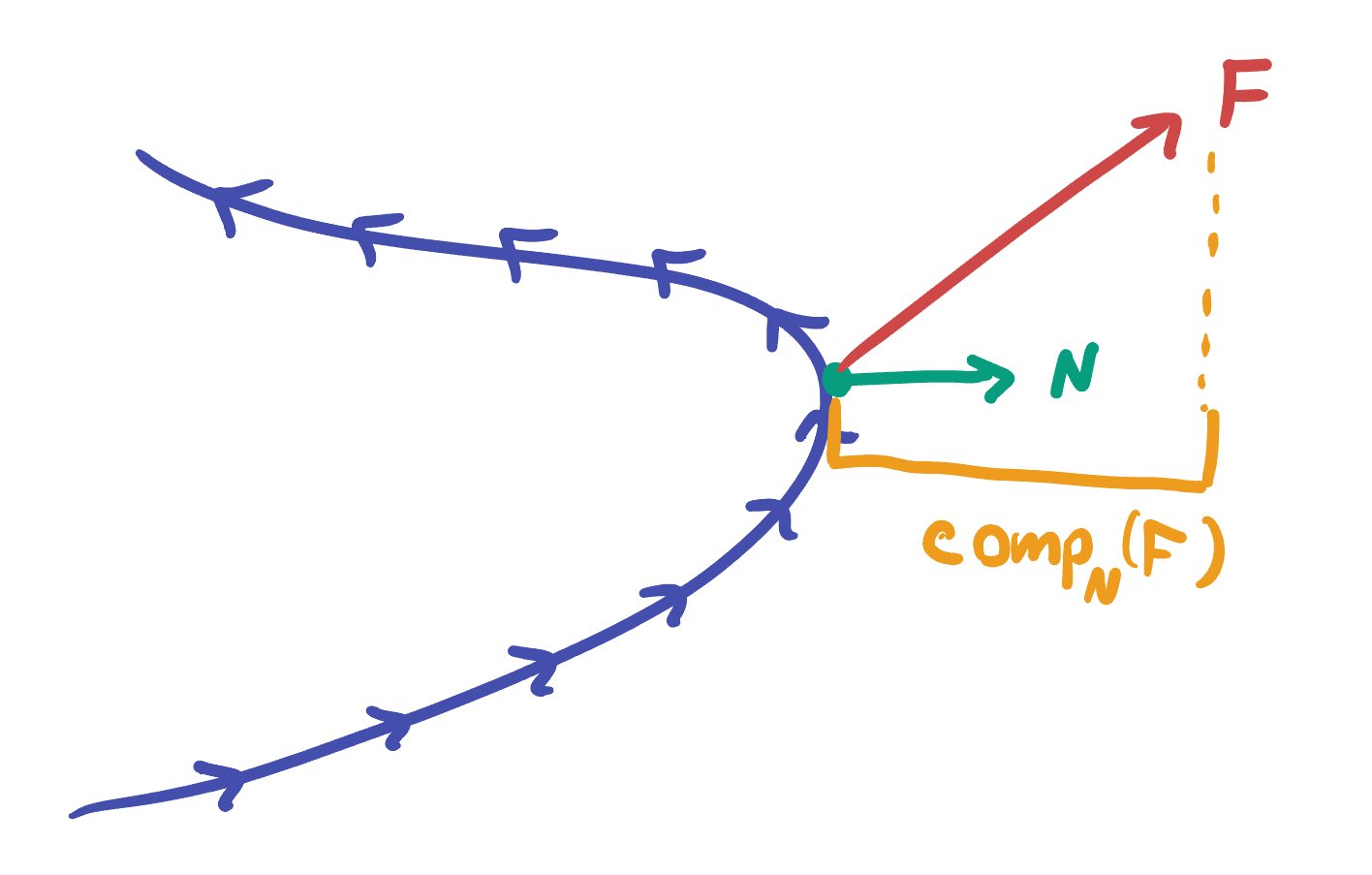
Definition 19.3 (Flux Integral) The flux of a vector field
We again try to unpack this definition using an actual parameterization of the curve
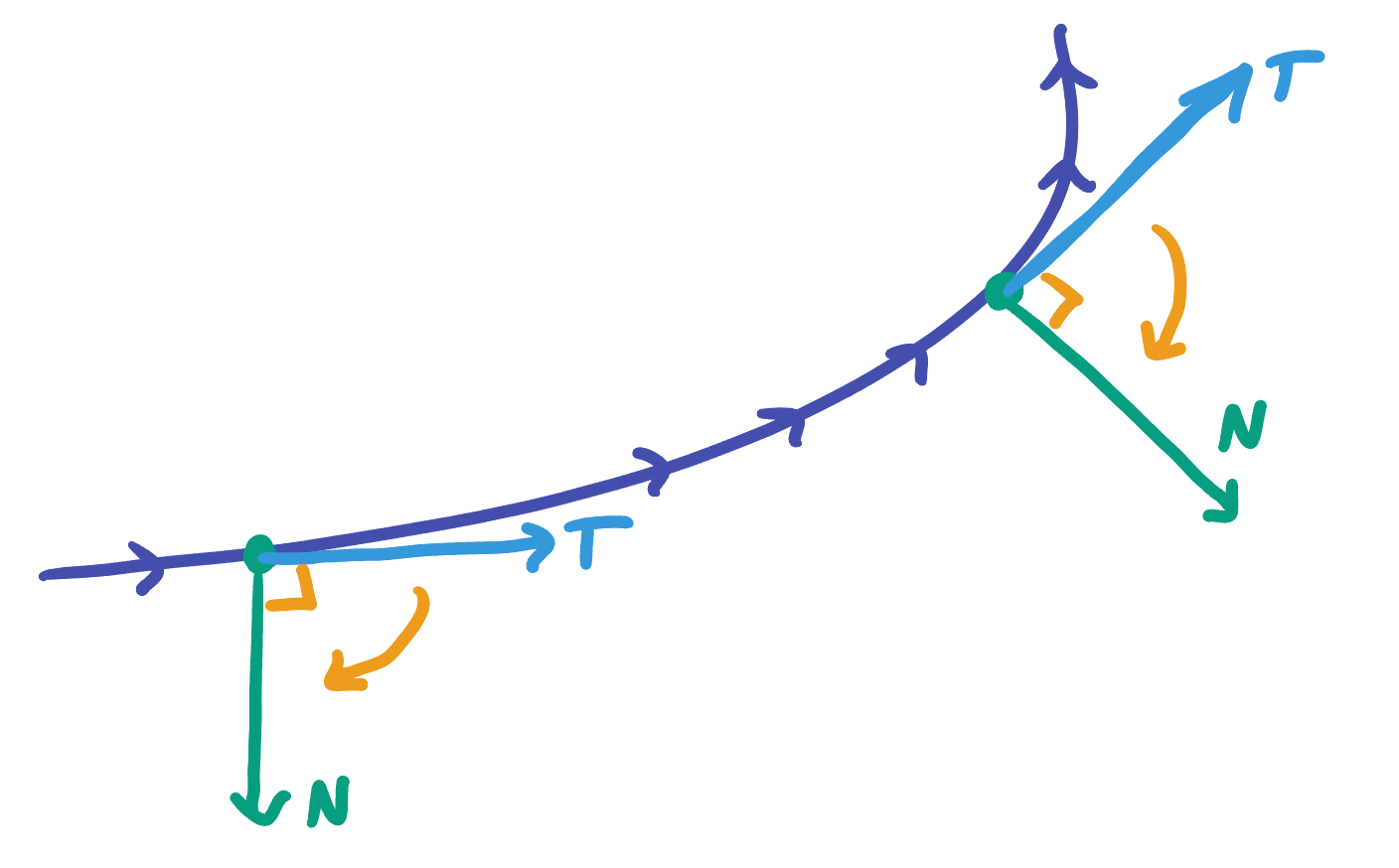 How much of
How much of
Such a rotation is accomplished by the transformation
This also simplifies greatly inside of the line integral, since the length of
Actually performing this dot product for
This is itself just a cross product!
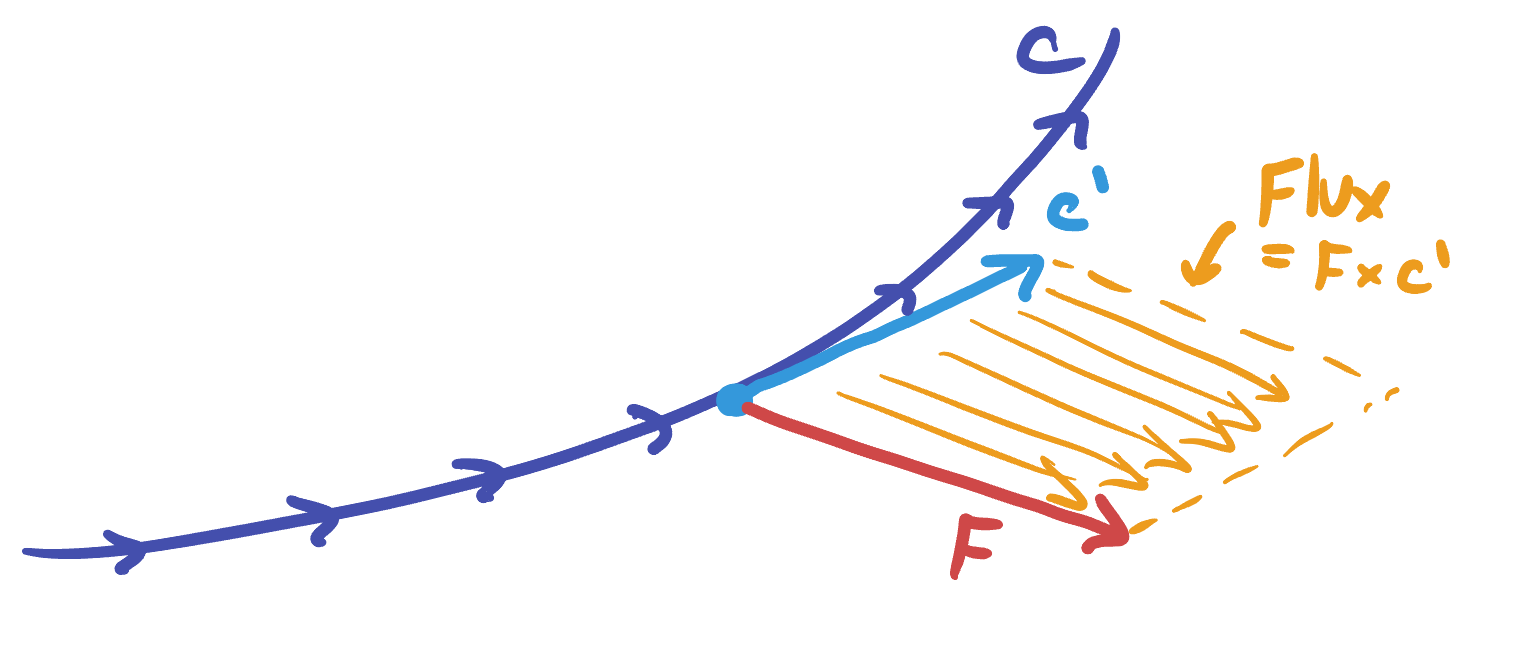 This has a nice interpretation: this parallelogram is made of many parallel copies of
This has a nice interpretation: this parallelogram is made of many parallel copies of
In addition to being a memorable picture, this new formula lends itself directly to computation, so let’s record it in a box and do an example
Theorem 19.2 Given a vector field
Example 19.2 Compute the flux of
We start by writing down this standard parameterization
Taking the cross product gives the integrand
Integrating then directly gives the flux
For consistency we can also seek better, more memorable notations for the flux integral like we did for circulation. The integrand
Definition 19.4 (Notation for Flux Integrals) Given an oriented curve
19.3 Circulation and Flux in 3 Dimensions
The defintiion of circulation remains unchanged in three dimensions, as it still makes perfect sense to try and measure how much a 3D vector field aligns with a 3D curve. Indeed, the formula remains the same, integrating the tangential component along the curve, and the entirety of the previous discussion goes through just with one added coordinate

Definition 19.5 (Circulation in 3D) Given a vector field
Example 19.3 Compute the circulation of
Again we find
(While it won’t be relevant to our course, this definition continues to make sense in all dimensions, via the exact same formula).
Turning to flux, it perhaps comes as no surprise that things must change. There are both conceptual and formulaic problems with trying to naively apply our earlier formulation:
- The formula involves a cross product, and this changes from a scalar quantity to a vector quantity in 3 dimensions, but we still want our overall integral to be a scalar.
- Flux is supposed to measure the flow through something. But a curve does not separate two regions in 3D space like it does in the plane, so there’s no natural inside and outside.

Both of these problems are fixed by realizing that the natural notion of a flux integral in three dimensions needs to be a surface integral instead of a line integral. This is the only change to the definition: flux is still the normal component of the vector field
Definition 19.6 (Flux Integrals in 3D) The flux of a vector field

Using our previous experience, we should try to simplify this formula a bit, hoping that any square roots hidden in the definition of the normal component cancel out with square roots in the definition of
and then finding the area of the parallelogram they span by taking the magnitude of their cross product
For us now, its very convenient to note that before taking this magnitude, the cross product is itself a normal vector to our surface (in fact, it is the upward facing normal)
If we use this normal vector, the simplifications that happen in our formula become more apparent:
This gives an easy formula to calculate the flux integral over a surface
Theorem 19.3 (Flux Integrals in 3D) The flux of the vector field
 The upward facing normal.
The upward facing normal.
At this point an example is in order
Example 19.4 Calculate the flux of
We can compute the vector field on our surface by substituting
This gives the integrand
The flux integral is then just this over the domain, which is the unit circle
This integral is best computed by converting to polar coordinates.
This same idea works for general parametric surfaces with little change: if we write
Theorem 19.4 (Flux Integrals over Parametric Surfaces) The flux of the vector field
A final note: the most common use case (in physics, and electrical engineering) involves
 Making sure to get the outward normal everywhere means drawing a picture and figuring out which pieces need upwards vs downwards normals.
Making sure to get the outward normal everywhere means drawing a picture and figuring out which pieces need upwards vs downwards normals.
Example 19.5 Calculate the flux of
The top half of this problem is exactly the same integral as in the previous example. To do the bottom half, we deal with the unit disk
So, for this second integral
This is just